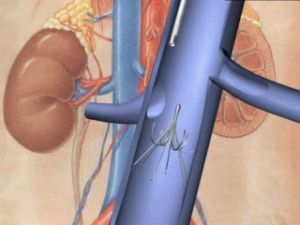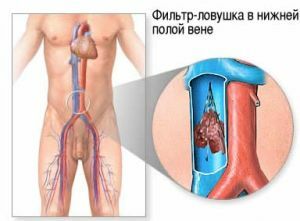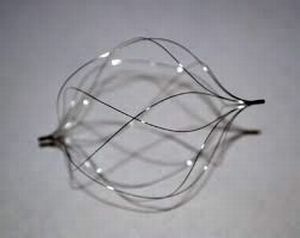 A thrombus is a dense blood clot that is formed from blood cells that are fastened with filaments of fibrin protein. Usually, thrombi form in the vessels or in the heart.
A thrombus is a dense blood clot that is formed from blood cells that are fastened with filaments of fibrin protein. Usually, thrombi form in the vessels or in the heart.
Thrombi consisting of platelets are formed in the arteries with accelerated blood flow. Thrombus veins are formed with a slow blood flow.
Heart thrombi form in the heart with heart defects and endocarditis, in large arteries blood clots form at atherosclerosis, and in veins - with thrombophlebitis. The thrombus dissolves with a favorable outcome.
If the outcome is unfavorable, the thrombus leads to embolism or may be purulent melt.
PE is acute cardiovascular pathology of caused by sudden clogging of the embolus in the form of a pulmonary thrombus. Often thrombi appear in the right heart or venous vessels and cause a violation of the blood supply to the lung tissue.
In this case, PE has a high mortality rate, the reasons for it lie in untimely diagnosis and inadequate treatment.
Contents
- Methods for treating PE of
- Installing a cava filter as a method for treating PE of
- Indications and contraindications for the installation of the
- device What is a cava filter
- Installing an
- device Possible complications during and after installation
Methods for treating PE of
In an acute period,preservation of the patient's life, in the long-term period the treatment is based on the prevention of possible complications and the prevention of repeated cases of PE.
The main directions of in the treatment of PE:
- correction of hemodynamic disorders;
- process of removal of thrombotic masses;
- recovery of pulmonary blood flow;
- prophylaxis of recurrent thromboembolism.
When diagnosing segmental PE, accompanied by small hemodynamic disorders, there will be enough anticoagulant therapy.
Anticoagulants can stop the progression of an existing thrombosis.
In hospital conditions, it is recommended to use low molecular weight heparins without hemorrhagic complications that have high bioavailability, which do not affect the process of functioning of platelets and are easily dosed when used.
Installing a cava filter as a method for treating a pulmonary embolism
A cava filter is an medical device implanted in the lumen of the inferior vena cava to catch blood clots that are carried by the  blood stream. A device like a cava filter passes blood, but it creates an obstruction for blood clots.
blood stream. A device like a cava filter passes blood, but it creates an obstruction for blood clots.
Often thrombi appear in the veins of the legs. When the blood flow slows down, a prerequisite to the onset of a thrombus arises. If the thrombus breaks away from the venous wall, it flows with the blood flow into the right heart.
And from there gets into the pulmonary artery, which causes thromboembolism - a very dangerous complication, which can end and death.
Therefore, for the prevention of PE it is necessary to implant a cava filter.
This method has the advantage of being able to avoid complications associated with the presence of the cava filter on an ongoing basis.
It should be noted that the cava filter does not affect the risk of thrombosis itself, since it does not affect the cause of thrombi itself. It only helps to prevent embolism of the pulmonary artery by a thrombus, which has come off.
Usually a cava filter is used when other treatments are no longer effective.
The cava filter itself is an metal device , which looks like an umbrella, tulip or bird's nest. A cava filter is installed endovascularly, through a vein, without carrying out any operation.
 In what cases is rheovasography of the lower extremities appointed? What nuances of procedure exist you can learn from our material.
In what cases is rheovasography of the lower extremities appointed? What nuances of procedure exist you can learn from our material. Irreplaceable medications in medicine anticoagulants of direct and indirect action - what medicines should I choose?
Indications and contraindications for the installation of the
device Indications for the installation of the cava filter:
- deep vein thrombosis in flotation thrombi of the lower limbs( a permanent cava filter is needed);
- deep vein thrombosis in heart failure, coronary heart disease, in cancer patients;
- episodes of PE in the past, as well as in the presence of currently venous thrombosis of the lower extremities( permanent cava filter);
- operations on veins, laparoscopic interventions for thrombosis of the pelvic veins( cava filter is temporarily located in the vein for the period of operation, as well as postoperative time).
Some cava filters are placed for life in the vein. Temporary cava filters are implanted on average to 6 months, and after elimination of problems that can increase the risk of PE, - are removed.
Installation of filters is contraindicated if is available:
- risk of septic embolism;
- infectious, uncontrolled diseases;
- diameter of the inferior vena cava is more than 30 mm;
- , there are contraindications to the intervention under fluoroscopic control;
- hypersensitivity to components.
What is a cava filter

In the photo, the temporary cava filter
The cava filter is an high-tech grid that is located on the complex structure of the .It is installed in the lumen of the lower vein.
Installed in this way, the cava filter delays particles larger than 2-4 mm. This leads to the free passage of red blood cells and other cells through the filter, the retention of large blood clots.
As a result of the anti-coagulant system of the body, anticoagulant preparations taken, the dissolution of the stuck thrombi begins directly on the cava filter.
If the filter is properly installed, there is no need to intervene again.
Cava filter is a foreign element in the body, but modern designs of these filters are such that the process of thrombus formation on the filter is rarely observed.
Installing the
Installing the cava filter is a simple procedure. Thanks to high-tech equipment, the implantation takes about sixty minutes.
The methods of introducing a cava filter are different, depend on the physiological characteristics of the body, and even the state of health of the patient.
Access to the cava filter setting is selected by the in the hip area. All this happens under the supervision of radiologists who initially determine the possible location of the thrombus.
Before the installation procedure, the patient is anesthetized. As a rule, only superficial anesthesia is used. This relieves the patient of pain at the time of implantation and other unpleasant sensations.
A special conductive device allows the cava filter to be transported to the desired installation site. When the cava filter reaches this site, it opens itself and is brought into operation.
The conductor is then removed, after this procedure, no overlapping of seams and other procedures for the restorative process of the skin.
Cava filter, hitting the cavity of a blood vessel, is attached to its wall, this is facilitated by the temperature of the human body. Cava filters have special  tags, which are gold rings and allow a good view of the structure on the X-ray machine.
tags, which are gold rings and allow a good view of the structure on the X-ray machine.
The process of installing cava filters is possible even in curved, as well as strongly wriggling vessels. Their motion along the vessels is controlled by means of special rings, which create a contrasting reflection.
At the end of the procedure, an additional radiography is mandatory to monitor the correct installation of the cava filter.
Possible complications during and after installation of
The introduction of a cava filter can lead to the development of various infectious complications, as well as damage to the vessel.
Rarely , a filter is detached from the site of its implantation and its entry with blood flow into the heart or pulmonary vessels. To prevent the development of complications, the patient is prescribed a strict bed rest for 2-3 days and the administration of antibiotics.
During the whole period of implantation, the patient's condition is observed by automatic equipment, with her doctors constantly monitoring the level of pressure, palpitation and other indicators.
